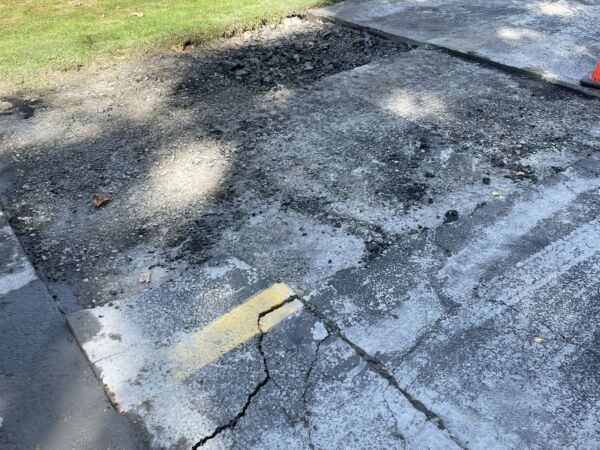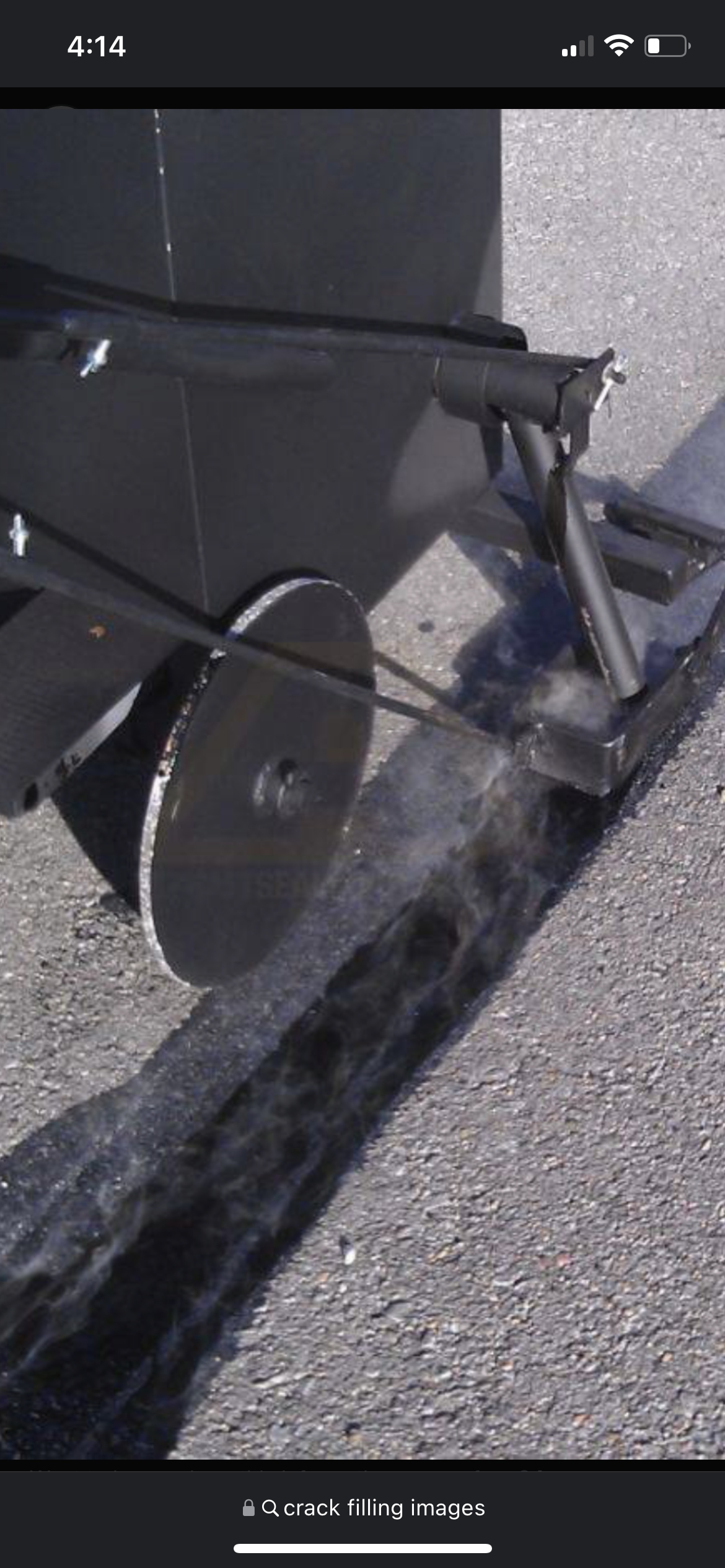Crack Filling
As a commercial building owner, you may be familiar with asphalt crack filling. It is essential to maintaining your property and can help prevent further damage. Asphalt crack filling involves identifying the problem areas, selecting the appropriate type of repair for each site, and completing all necessary steps to ensure the repaired surface remains stable over time.

How to Identify an Asphalt Crack Problem?
Identifying the warning signs of a shaky foundation is critical before it’s too late. If any visible splits in the asphalt are noticed, this could be a sign of underlying issues with your pavement. Additionally, any cracking or crumbling around the edges and corners of your asphalt pavement can indicate potential problems below the surface.
Visible Cracks in the Surface:
Visible cracks in your asphalt surface can range from minor hairline fractures to large chunks missing from your pavement. At first, slight splits may not appear significant; however, they can quickly expand and cause more harm if neglected. More significant gaps in the asphalt should be addressed immediately as they could lead to further instability down the road.
Black Magic Asphalt Maintenance
Offers slurry seals, sealcoating, chip seals, and more to help keep your pavement looking great. Pavement preservation through crack filling is essential for extending pavement life and keeping surfaces smooth for safe travel conditions on driveways and parking lots.
Identifying an asphalt crack problem is essential for preserving the integrity of a commercial building’s foundation. It is important to understand what types of asphalt crack filling are available to ensure that the correct repair method is chosen.
What are the Different Types of Asphalt Crack Filling?
Asphalt crack filling is a process used to repair and maintain asphalt surfaces. It involves using various materials, such as hot-pour crack fillers, cold-pour crack fillers, and polyurethane foam injection methods. Before deciding on the most suitable solution, one must weigh the advantages and disadvantages of each type of material.
Frequently asked questions.
Crack filling is an integral part of asphalt maintenance as it prevents further damage to the pavement. If left untreated, cracks can cause water to seep into the subgrade and weaken its foundation. This leads to more extensive repairs such as pothole patching or total resurfacing. The crack filling also helps maintain a smooth driving surface, improving safety for drivers and pedestrians. Finally, crack filling extends the life of your asphalt by preventing further deterioration from occurring due to weather conditions like freezing temperatures or heavy rains. By taking proactive measures with regular crack sealing and repair services, you will save money in the long run while protecting your investment in commercial buildings’ parking lots and driveways
Crack sealing is an integral part of asphalt maintenance and should be done regularly to extend the life of your pavement. It involves filling or sealing cracks wider than 1/4 inch with hot rubberized material. The process helps prevent water from entering the trial, which can cause further damage over time. Clear out any particles in the fissure and make sure it is arid before adding caulk. Afterward, use a squeegee or brush to spread the sealant evenly across the sealed area. Once it’s finished, please allow enough time for drying before driving on it again.
A hot pour crack filler is the best way to fill cracks in asphalt. This type of product is designed for damages up to 1” wide and will provide a durable seal that can withstand extreme weather conditions. For optimal results, the hot pour crack filler should be heated and stirred before application when temperatures are between 50-90 degrees Fahrenheit. The material must also be mixed well before use, ensuring an even spread throughout the treated area. Once applied, it needs time to dry completely before any traffic, or other activity takes place on top of it.
Yes, asphalt cracks should be filled. Filling gaps helps prevent further surface damage and deterioration, which can become costly in the long run. It also improves safety by reducing tripping hazards for pedestrians and vehicles. Additionally, filling cracks is a cost-effective way to maintain an aesthetically pleasing appearance for commercial buildings, as it enhances curb appeal. When done correctly with quality materials by experienced professionals, crack filling is an effective way to extend the life of your asphalt surfaces.

What are the Steps Involved in Asphalt Crack Filling?
The first step in asphalt crack filling is to clean and prepare the area for repair. This includes removing any loose debris from the surface, such as dirt or leaves, that could prevent a proper sealant application. It also involves using compressed air to blow out dust or other material that may have collected in the cracks. Once the surface is cleared, it’s essential to guarantee that everything is dehydrated before fixing it.
Once the area is prepped, it’s time to apply an appropriate sealant or filler.
Asphalt crack filling is an essential part of any asphalt maintenance program. To ensure a long-lasting repair, it’s necessary to maintain your newly repaired surface with regular inspections and sealcoating every two to three years and professional maintenance annually.
To ensure a prolonged lifespan of the newly mended asphalt, it is necessary to take care of it. Regularly inspecting the pavement for damage or wear and tear is vital, along with sealcoating every two to three years and having professional maintenance done annually.
Inspecting your pavement regularly helps you identify any potential issues early on before they become more significant problems down the line. Keep a lookout for any splits, cavities, or changes in hue of the surface dips or lumps on the roadway – these are all indicators that something needs to be addressed. If you spot anything unusual during your inspections, contact an experienced asphalt contractor, like Black Magic Asphalt Maintenance immediately so they can assess what repairs need to be made and how soon.
Sealcoating your pavement every two to three years will help keep it looking great and protect it from further damage caused by UV rays, rainwater infiltration, and general wear and tear over time. Sealcoat also allows fill small cracks, which could otherwise lead to larger ones if left unchecked; this process also prevents water from seeping into them in the first place.
Finally, it is recommended to have professional maintenance done annually by an experienced contractor who knows exactly what needs doing and when. Preventing significant issues that could cost more money in the future is critical, so it’s best to take care of minor repairs promptly. It is always better to be safe than sorry when dealing with asphalt repair projects; do not skimp on quality materials or labor costs here.
Crack Filling
Asphalt crack filling is an essential step in preserving the integrity of your asphalt surface. It prevents further damage, reduces trip hazards, and helps maintain a safe environment for everyone who visits or works on your property. By adequately identifying any cracks that may be present and selecting the correct type of asphalt crack filler to use, you can ensure long-term protection against future cracking problems. Proper maintenance can also extend the life expectancy of your newly repaired pavement surfaces. Asphalt crack filling should be noticed as it is one of the most cost-effective ways to preserve and protect your paved surfaces.If you’re looking for a reliable and cost-effective solution to asphalt maintenance, patchwork, pothole repair, crack filling, or sealcoating – look no further than Black Magic Asphalt. We provide superior quality services that will keep your pavement in top condition!
To properly repair asphalt cracks, one must clean and prepare the area by removing loose debris before applying an appropriate sealant or filler material. Hot-pour materials tend to be more durable and form a better bond, while cold-pour products can be less expensive but require extra care when used for repairs.
To ensure long-lasting pavement, inspecting the asphalt regularly for cracks or damage and having sealcoating done every two to three years is essential. Moreover, an experienced contractor should conduct professional maintenance annually so that any minor issues can be addressed before they turn into costly repairs.
